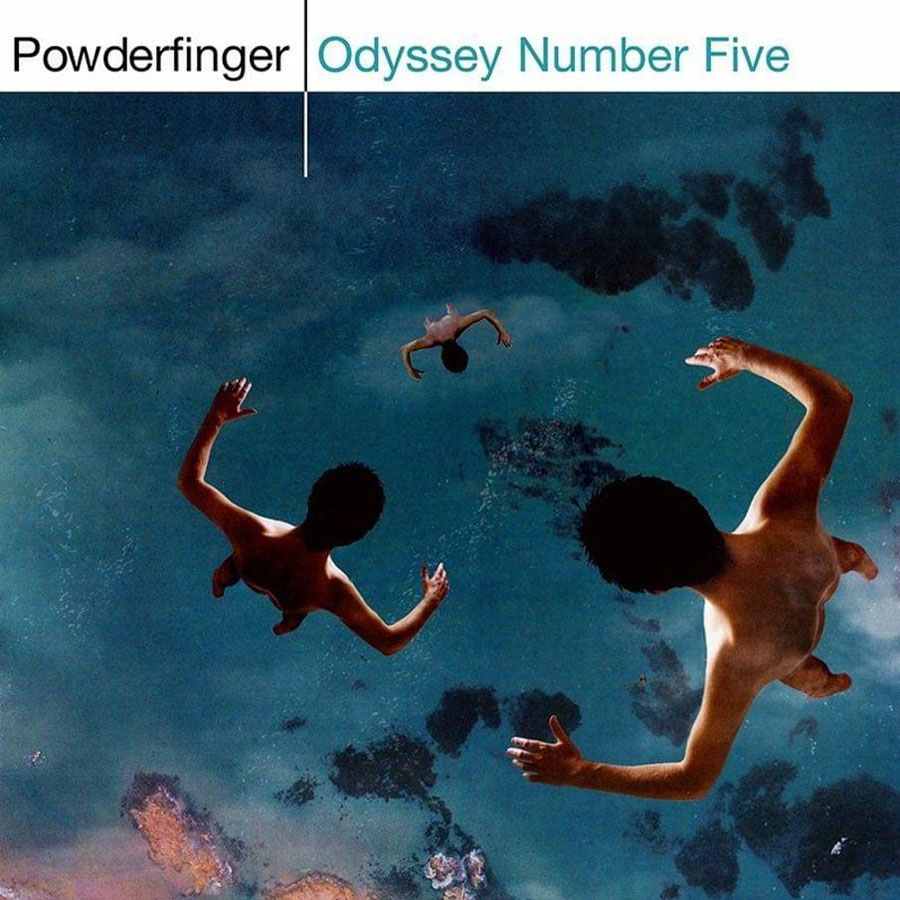Odyssey Number Five is a totemic work in the Australian rock canon, capturing some of Powderfinger’s most mature and endearing songcraft.
20 years on, Powderfinger’s Odyssey Number Five plays like a greatest hits album, encapsulating everything mighty about one of Australia’s most recognisable bands. It’s the Finger’s most successful release to date, boasting two of their most enduring anthems: These Days and My Happiness — which topped Triple J’s Hottest 100 in 1999 and 2000 respectively.
The evocative, surreal imagery of the album cover is reflected in singles like My Kind of Scene, Like A Dog and Waiting For The Sun — tracks that have become timeless classics in the group’s oeuvre. In 2011, the album was voted number 1 in Triple J’s Hottest 100 Australian Albums Of All Time. But it was a long road to get there.

Powderfinger already received mainstream success with the release of 1998’s Internationalist. It was the sound of the band finally coming into their own after years of restlessly finding their sound. It was hard to consider how that album could be topped.
With their subsequent release, however, they did just that. Odyssey Number Five is the sound of the band hitting its stride. At album number four, this is the sound of Powderfinger — at the turn of the century and 20 years later, it’s as vital as ever.
You know exactly where you’ve been…
In 1996, Powderfinger released the song Pick You Up. It was championed by Triple J and broke them into the mainstream. As their manager Paul Piticco reflected in the SBS series Great Australian Albums, “it was a seven-year overnight success.” That’s a long time trying to make it in the business and most bands would have thrown in the towel.
Part of Powderfinger’s enduring legacy is their persistence through the post-grunge/alt-rock scene of the ’90s and finding their own voice within it. But it wasn’t until Odyssey Number Five that they began imagining a more expansive vision for their band. Despite this grand ambition, they would continue to downplay their image throughout their career, coming across as the kind of cricket-loving blokes you’d meet at the backyard BBQ.
Powderfinger formed in Brisbane, 1989 by school friends Ian ‘Hoggy’ Haug on guitar and vocals and John ‘JC’ Collins on bass. They bonded over their love of Aussie bands like The Sunnyboys and The Church and would wear their influences on their sleeves. Hoggy would later become a fulltime recording and touring member of The Church post-Powderfinger.
With the addition of Bernard ‘Bernie’ Fanning upfront, Darren ‘DZ’ Middleton on guitar, and John ‘Cogsy’ Coghill on drums the line-up was complete. They took their name from Neil Young‘s song Powderfinger and replicated his blues-rock style in the early days.
By 1992 grunge had well and truly taken off and blues-rock was far from the zeitgeist. As Bernie explained in the 2018 documentary There’s No Escape:
“You had to be anti-corporate, you had to be anti-commercial, being successful was a fucking embarrassment to you and your local scene and blah blah blah. And we were just like… well fuck that! Why are you in a band? Are you in a band so less people come to see you and less people buy your records? Is that the idea?”
Powderfinger released their debut album Parables for Wooden Ears in 1994. Full of changing time signatures and complex arrangements, the album was not a huge commercial success. The name of the album was a variation on ‘Songs for the Deaf‘ and if that sounds familiar, it’s because it was picked up several years later by Queens of the Stone Age.
Their 1996 followup, Double Allergic, would contain the breakthrough single Pick You Up and was a step toward the mainstream. On this album, they took the lessons from Parables and boiled them down to a more palatable listening experience. This path would continue into the production of their next album and success beckoned.
What are you looking for this time around?
On Internationlist, Powderfinger’s explosive third album, the quintet’s sound was further crystallized on songs like The Day You Come, Already Gone and Belter. Much of this success in executing these ideas was due to the guidance of American producer Nick DiDia who’d worked with acts like Pearl Jam, Rage Against the Machine and Bruce Springsteen.
Passenger would go on to be the highest-selling single from the album thanks to its B-Side, a little song called These Days.
Following the release of the album, filmmaker Gregor Jordan approached the band to write a song for the climax of his debut feature Two Hands. The 1999 film was shot in Sydney with veteran actor Bryan Brown and would launch the careers of Heath Ledger and Rose Byrne.
Bernie was quick to find inspiration when he was shown the emotional finale of the film. The lyrics in These Days merely reflected the main character’s state of mind. No one in the band could have guessed how impactful the song would be, providing their 2020 reunion show One Night Lonely with an unforgettable emotional climax.
And to think the song’s minor chord change into the chorus was a happy accident. Bernie was stuck on how to get out of the verse, calling out to his housemate for any random chord he could think of – “D minor!”.
These Days became a landmark song for the band and provided a bridge into the next album.
Into the safe arms that I know
The M.O. for Odyssey Number Five was to create a more cohesive experience than the multi-directional approach of Internationalist. The album begins with Hoggy’s rhythm guitar, belting out four chords that signal the band’s new intent. The reverb-drenched guitar was inspired by U2’s 1991 album Achtung Baby.
“This will be an uncertain time for us” sings Bernie in the opener, Waiting for the Sun. The group was grappling with the pressure of their own success and the effect that it had had on their lives — the songs on the album would reflect this new state of mind. But stress and interpersonal tensions can be a good thing for a record. Some of the most beloved albums have been made under such circumstances, just look at Let it Be or Rumours.
In a similar vein to Pick You Up — being written in a hotel room while on the road — Bernie wrote Waiting for the Sun after a difficult phone call with his girlfriend while on tour in New York. The song was originally intended to be mellow with shades of gospel and the sound of ’70s California. But once it was presented to the band, it evolved into the bombastic, arena rock song that’s become a live favourite.
If Waiting for the Sun set the tone, then the next track would set the standard. My Happiness is Powderfinger’s highest-selling single.
My Happiness reflects the life of a touring musician — living in and out of suitcases, hoping that someone will come home, and when they do, they go again. It’s become a staple at weddings, which the band feel is highly inappropriate!
With a mixture of 6 and 12 string guitars strumming underneath Bernie’s triple tracked vocals and Cogsy’s marching style groove, My Happiness would epitomise the expansive, sumptuous sound that the band desired and also function as a lead into The Metre.
By Odyssey Number Five, the band had reduced their songwriting process to a fine art. It was a five-sided democracy where the contributions were shared — like Hoggy and DZ swapping lead guitar roles between songs. If someone didn’t like a lyric, it was changed. And any major differences or blowups that would happen were quickly put behind them for the betterment of the whole.
So when DZ presented the humble beginnings of The Metre it wasn’t taken too personally when Bernie completely rewrote the melody and words — still keeping the title that originally lamented on the metre of time. For DZ, it was a career highlight to see the 12-piece string section he had in his head become a reality in the studio. The Metre was performed at the ARIAS in 2001, an extremely successful night for the band.
It’s a fine, fine time for the people in the lucky land
Powderfinger wasn’t afraid to get political.
They already dipped into the controversial territory on their previous outing with The Day You Come. On that track, the band gave the finger to Pauline Hanson. On Like a Dog, the same sentiment would be aimed at John Howard and the Liberal government for their attitudes towards Indigenous Affairs.
Hoggy was sceptical about being seen as a political band — they didn’t want to be another Midnight Oil. Bernie’s lyrics provided the right balance of attack and prowl. Like a Dog would feature some of his best; “Now he nervously shakes when we rattle his stage, but he’s happy to be stuck back in his halcyon days. Now we’re trying hard to reconcile a history of shame, but he reinforced the barriers that keep it the same”.
The song took shape in the rehearsal room with Hoggy’s dirty riff and JC’s growling bassline. It was their chance to sound like Iggy Pop or
Public Image Ltd and provided the right groundwork to let out their aggression towards John Howard’s refusal to apologize for the Stolen Generation. Triple M refused to play the single at the time of its release, finding it too confronting.
The band all shared similar views politically and stood united in their attitudes towards reconciliation politics. This was reflected years later when they teamed with Silverchair for the Across the Great Divide tour in 2007. The aim of the tour was to increase awareness of the efforts of Reconciliation Australia to reduce the current 17-year gap in life expectancy between the average Australian life and that of Indigenous Australians.
The iconic music video for the song was shot at Festival Hall with boxer Anthony Mundine who would pummel Bernie by the end of the clip. Like their previous videos where Bernie would meet a grisly end, Like a Dog skewered the symbolic importance of the lead singer.
Welcome to the new suburban fables
With the stress of the sessions easing, the band would assemble at the studio before Nick DiDia’s arrival to hammer out more tracks for the album. The plan was to connect the main songs with little ‘Odysseys’. However, only one Odyssey made it onto the final album. And it’s where the album gets its grandiose title.
The album’s biggest jam is the song Thrilloilogy. The epic track closes out their ‘oipic’ trilogy started on Double Allergic. A live favourite for band and punters alike, the song was written as a kind of one-song set that was dynamic in its trajectory across its 6-minute and 8-second duration.
The band wanted to continue the lush sounding arrangements of songs like Day You Come and Passenger with a focus on more spacious, dynamic songs with fewer stomps on the distortion pedal. Up and Down and Back Again is a fine example of this and features a rarity for a Powderdinger song: a key change! It was a setlist staple when performed live as a solo piece by Bernie.
Before recording the album, the band found out that action-man Tom Cruise had become a fan of theirs and wanted a song on the new Mission Impossible II soundtrack. His choice was My Kind of Scene, one of the group’s best sing-along ballads and inspired by the hymns from Bernie’s choirboy days. Their inclusion on the soundtrack put them alongside acts like Foo Fighters and Metallica and it would lay the groundwork for their break into the North American market.
Nick DiDia’s contribution to the record can’t be understated. It’s clear in the track We Should be Together Now, which the band was initially hesitant about putting on the album. But it was DiDia’s vision for the piece that would make it the perfect foil for a riff-laden rocker like Like a Dog.
The song would be a fusion of styles, laying the drums in a hip-hop loop and assembling the instrumentation in a Tetris-style arrangement. Bernie’s double octave vocal helps the song leap out of the stereo. It was a harbinger of the edgier sound that was to come on the next album – Vulture Street.
The album’s closing track, Whatever Makes You Happy, deals with loss and grief in a gentle, simplistic arrangement. The organ-tinged finale provides a majestic and bittersweet sendoff to a defining chapter in the band’s history.
All I really want is for you to stay
When Odyssey Number Five was released, it went straight to number one in Australia and Powderfinger became mainstays on the international touring circuit. They would play Japan’s Fuji Rock Festival where they would meet the man that inspired their name all those years ago. Neil Young would dedicate his performance of the song Powderfinger to them.
Back at home, they helped make Splendour in the Grass become one of the biggest festivals in the country as its first headline act. Their New Suburban Fables tour that followed was one of the biggest Australian tours since the heyday of Aussie rock with Cold Chisel and INXS. The 2001 shows saw the album climb back into the charts a year after its release.
My Happiness received plenty of airplay in the US and after a successful tour with Coldplay, riding high on their single Yellow, the group were set to conquer the States. But it was not meant to be. When the events of Septemeber 11 prevented a followup tour, Powderfinger decided to focus solely on their Australian audience.
Even following their breakup in 2010, this album continues to resonate. Their reunion concert was streamed by hundreds and thousands of fans and on the eve of Odyssey Number Five’s 20th anniversary, the announcement was made to much excitement that new Powderfinger music is on the way.
My happiness is slowly creeping back…



